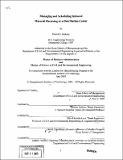Managing and scheduling inbound material receiving at a distribution center
Author(s)
Jackson, David O. (David Oliver)
DownloadFull printable version (5.131Mb)
Other Contributors
Leaders for Manufacturing Program.
Advisor
Jéréme Gallien and David Simchi-Levi.
Terms of use
Metadata
Show full item recordAbstract
In any distribution system the processing of inbound material has significant indirect impact upon the customer experience. The inbound process encompasses all the steps to get a product into the distribution center (DC). It starts with the inventory and procurement policies and ends with the product being in a physical storage location at the DC. In order for a product to be sold to a customer it must first be brought through this inbound process (with the exception of drop shipping) and therefore it is important for this to be completed in a timely and predictable manner. However, from the perspective of a given distribution center within a network, there is significant variability of product arriving at the facility. The need to get product into inventory quickly and predictably must be balanced with the significant challenges of handling this variability. The variability can come from a variety of upstream sources: the procurement policies, the vendors/manufacturers, or the inbound transportation providers. At one facility in the Amazon network the day to day standard deviation of variability was approximately 15-30% of units. This variability must be handled efficiently at the facility while balancing all of the other operational goals of the distribution center. The goal of this research is to analyze the inbound system at one online distributor - Amazon.com - to measure the inbound variability and to perform an investigation into methods for handling the inbound variability to the distribution center. This research is applicable to any distribution company looking to manage outbound service levels through improvements on the inbound system. (cont.) This thesis will focus on two key practical methods for handling the variability in the inbound product arrival: 1. management and scheduling of the labor workforce (labor supply) and 2. managing the release of work into the distribution center (work demand).
Description
Thesis (M.B.A.)--Massachusetts Institute of Technology, Sloan School of Management; and, (S.M.)--Massachusetts Institute of Technology, Dept. of Civil and Environmental Engineering; in conjunction with the Leaders for Manufacturing Program at MIT, 2005. Includes bibliographical references (p. 67-68).
Date issued
2005Department
Leaders for Manufacturing Program at MIT; Massachusetts Institute of Technology. Department of Civil and Environmental Engineering; Sloan School of ManagementPublisher
Massachusetts Institute of Technology
Keywords
Sloan School of Management., Civil and Environmental Engineering., Leaders for Manufacturing Program.